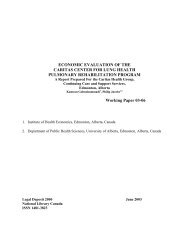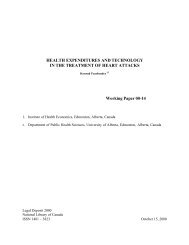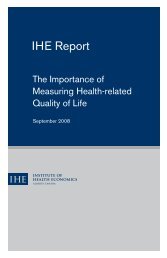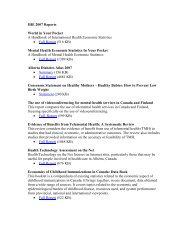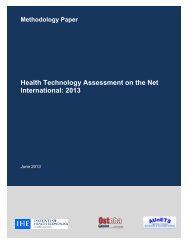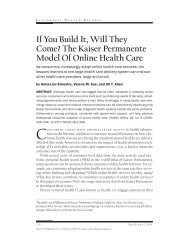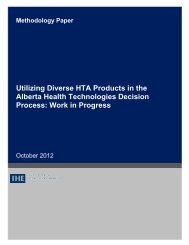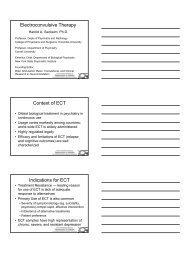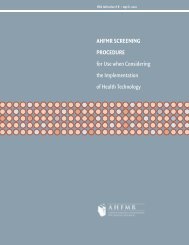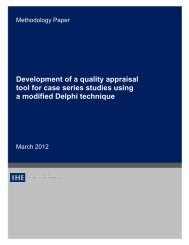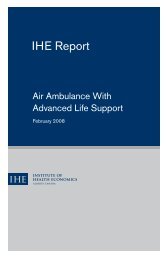Bariatric treatments for adult obesity - Institute of Health Economics
Bariatric treatments for adult obesity - Institute of Health Economics
Bariatric treatments for adult obesity - Institute of Health Economics
- No tags were found...
You also want an ePaper? Increase the reach of your titles
YUMPU automatically turns print PDFs into web optimized ePapers that Google loves.
SECTION THREE: ECONOMIC EVALUATIONCharles Yan, PhD, Andy Chuck, PhD, MPHECONOMIC ANALYSIS (E)Objectives and Policy QuestionsThe objective <strong>of</strong> the economic analysis was to address the following issues:1. Cost comparisons (effectiveness or utility analyses) in the short-term and in the long-termand the potential <strong>for</strong> one treatment strategy to replace another in a given sub-population.2. Unit cost estimates, including physician billings, hospitalization or facility operational costs,other service costs and capital costs, <strong>for</strong> the procedure as well as related health services.3. Estimates <strong>of</strong> patient and public demand, including prevalence and incidence <strong>of</strong> condition(s);utilization rates <strong>of</strong> standard or alternative <strong>treatments</strong>, where data exist; and estimates <strong>of</strong> theuse <strong>of</strong> the new technology taking into account service capacity, where feasible, as well asappropriate clinical indicators <strong>for</strong> use.Issue 1 was addressed by a systematic review <strong>of</strong> the economic literature to determine thecomparative cost-effectiveness <strong>of</strong> alternative interventions <strong>for</strong> <strong>obesity</strong>. Issue 2 was addressed byconducting a secondary analysis <strong>of</strong> provincial health service utilization data to estimate the directhealth services cost associated with bariatric surgery in Alberta. Issue 3 was addressed by conductinga secondary analysis <strong>of</strong> provincial health utilization data linked with the 2007 Canadian Community<strong>Health</strong> Survey (CCHS) to estimate the economic burden <strong>of</strong> disease associated with <strong>obesity</strong> inAlberta.MethodsReview <strong>of</strong> economic studiesSearch strategySelected databases were searched <strong>for</strong> economic evaluation studies <strong>of</strong> bariatric services publishedfrom 2000 to April 2010. Core Databases searched include MEDLINE, EMBASE, CINAHL, andWeb <strong>of</strong> Science, along with the Cochrane Database <strong>of</strong> Systematic Reviews (CDSR) and the Centre<strong>for</strong> Reviews and Dissemination Databases (DARE, NHS EED, and HTA). Refer to Table E.A.1 inAppendix E.A <strong>for</strong> the detailed search strategy.Selection criteriaThe search was limited to human and English-language publications. Studies investigating theeconomic, health service utilization, or cost impact <strong>of</strong> bariatric services <strong>for</strong> <strong>adult</strong>s on the healthsystem were included. Opinion articles (<strong>for</strong> example, opinions or letters to the editor) and abstractswere excluded. The selection <strong>of</strong> potentially relevant studies was reviewed by one reviewer.A recent 2010 CADTH report <strong>of</strong> bariatric surgeries 1 has been published that included a systematicreview <strong>of</strong> relevant health economic literature relating to bariatric surgeries and a primary costeffectivenessmodel comparing alternative bariatric surgical procedures, including standard care.Articles that were reviewed by the CADTH report 1 are not reviewed here; but rather a synthesis <strong>of</strong>their findings will be conducted. However, findings from the primary cost-effectiveness model willbe reviewed in this report.<strong>Bariatric</strong> <strong>treatments</strong> <strong>for</strong> <strong>adult</strong> <strong>obesity</strong> 160



